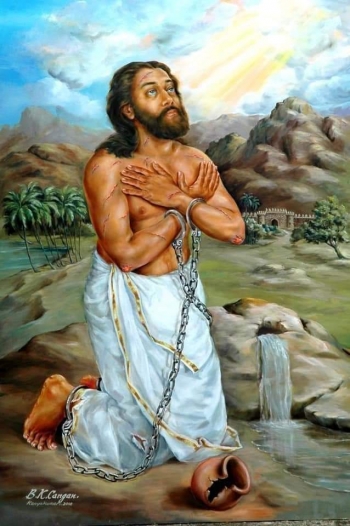
.png) Fr. J. Felix Raj
Fr. J. Felix Raj
.jpg)
Pope Francis will canonize Devasahayam (meaning God’s help), together with six others, during a canonization ceremony in St. Peter’s Basilica on May 15, 2022.
Blessed Lazarus, known as Devasahayam, was born into an affluent Hindu Nair-caste family at Nattalam in 1712 in the present-day Kanyakumari District of Tamil Nadu. Converted to Catholicism by a Jesuit priest in 1745, Devasahayam Pillai took the name Lazarus.
His father Vasudevan Namboodiri was working as a priest at Sri Adi Kesava Perumal temple in Thiruvattar. Devasahayam Pillai was raised by his maternal uncle, and was inculcated with Hindu beliefs and traditions from childhood.
Devasahayam's family had much influence in the royal palace of Maharaja Marthanda Varma, king of Travancore, and Devasahayam went into the service of the royal palace as a young man.  His capabilities and enthusiasm did not go unnoticed in the palace, as he was soon put in charge of state affairs as an official under Ramayyan Dalawa, the Dewan of Travancore.
In 1741, Captain Eustachius De Lannoy, a Dutch naval commander, was sent on command of a Dutch naval expedition by the Dutch East India Company to capture Colachel, a port under the control of Travancore, and establish a trading port there. In the battle of Colachel, the Dutch forces were defeated and the men were either killed or captured by the Travancore forces.
De Lannoy and the Dutchmen were later pardoned by the king on condition that they serve in the Travancore army. De Lannoy later earned the trust of the king and went on to become the commander of the Travancore armed forces.
It was during their influential roles under the King of Travancore that Devasahayam Pillai and De Lannoy became well acquainted. De Lannoy's Christian faith interested Devasahayam and De Lannoy enlightened him on the faith, leading to his conversion in 1745.
Pillai was married by this time to Bargavi Ammal and she also converted to Christianity. His wife was given the baptismal name of Gnanapoo Ammaal (equivalent to Theresa in Tamil & Malayalam). Some of Devasahayam Pillai's immediate family members also received baptism later.
Church chroniclers say that the Brahmin chief priest of the kingdom, the feudal lords, members of the royal household and the Nair community brought false charges against Devasahayam to the Dewan, Ramayyan Dalawa. Pillai was divested of his portfolio in the administration and was later accused of treason and divulging state secrets to rivals and Europeans.
He was arrested and tortured for three years. After his execution orders were passed, Devasahayam Pillai was marched from Padmanabhapuram Palace to Aralvaimozhy by soldiers, over the period of a few days. Pillai was treated like a criminal and as was customary in those days for criminals, his body was painted with red and black spots, and was intentionally marched through the streets sitting backward on top of a water buffalo (the mythical vehicle or vahana of Yama, the lord of death in Hinduism).
As a method of torture, he was beaten every day with eighty stripes, pepper rubbed in his wounds and nostrils, exposed to the sun, and given only stagnant water to drink.
While halting at Puliyoorkurichi, it is believed by Christians that God quenched his thirst by letting water gush through a small hole on a rock, the very place where he knelt to pray. The water hole is still found in the compound of a church at Puliyoorkurichi, about 15 km from Nagercoil. 
It is also believed that the leaves of a neem (Margosa) tree in the village of Peruvilai, to which he had been tied while being marched to Aralvaimozhy, cured illnesses of sick people in the village and around. 
He was let off in the forest hills near Aralvaimozhy where he is believed to have begun deep meditations, and the people from the adjacent villages began visiting the holy man. Christian sources allege that at this time, high caste Hindus plotted to do away with Devasahayam.
It was at Kattadimalai that Devasahayam Pillai was shot dead on 14 January 1752. The Izhasa Naadu Pandiyan soldiers in Pattazham Vilai sent Kamanayakkampatti traders to search the forest; they found Pillai's decomposed body and carried it to the Kottar Church.
His mortal remains were interred near the altar inside St. Francis Xavier's Church, Kottar, Nagercoil, which is now the diocesan Cathedral. 
Devasahyam Pillai's clothes and other belongings are kept in a church in the small town of Vadakkankulam. On 21 February 2020, Pope Francis recognized a miracle attributed to the intercession of Devasahayam, clearing his way to canonization (sainthood). Blessed Lazarus is the first lay person, a non-ordained member of the Church from India to be canonized.